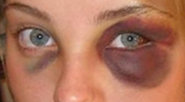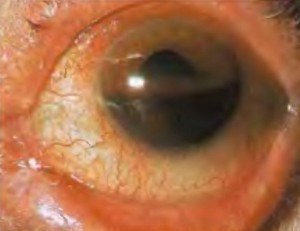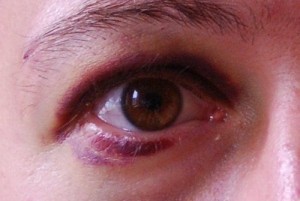Facts And Myths About A Black Eye (Periorbital Hematoma)
Visible bruising can occur anywhere on the body even though there is no break in the skin. Trauma may lead to damage deeper down in the skin which is visible from the outside. This is what happens with a black eye, also referred to as a blue eye or a shiner. Be it a punch, being struck by a fast moving ball or some other trauma to the eye area, a black eye is unsightly but it is rarely ever serious. The swelling and darkness may be ghastly but within a week or two it can clear up entirely.
Black and blue is blood
The darkness that we refer to in a shiner is actually due to blood under the skin around the eye. The injury that leads to a black eye causes tiny blood vessels under the skin to rupture. Blood leaks out and accumulates under the skin where it breaks down over time. It is this broken down blood that gives a shiner its bluish-black appearance. It should not be confused with dark circles around the eyes that occurs in some people. These dark circles are usually long term and arise from excessive skin pigment (melanin). It is not the same as a black eye where the bluish-black coloring is due to blood and not melanin.
Black eye is usually not serious
It is true that most black eyes are not serious. It is painful, can prevent the eyelids from opening properly and is unsightly but often it is not a serious condition. A black eye can pass in a week or two on its own even without treatment. However, sometimes a black eye or eyes may be more serious than it appears. If there is head injury which has also caused trauma to the brain and other structures within the skull, it can be potentially fatal. The symptoms may not be immediately obvious and all that can be seen is a black eye. Medical attention is therefore always advisable as you could be suffering with a skull fracture, concussion or bleeding within the skull and brain and not even know it.
Bleeding in the eye or around the eye
Although we call it a black eye and know that it is due to pooling of the blood, the problem often does not involve the eye itself. Instead it affects the tissue around the eye. Remember that the eye is inset within the skull in its own special cavity known as the orbit. Fat and connective tissue lie between this bony casing and the eyeball. In this way the eye is well protected as the hard bone around it takes more of the force. However, it is possible that the force is severe enough to rupture blood vessels in the eyeball itself which is much more serious. This is known as a hyphema when it happens in the front of the eye and can be easily seen from the outside.
Ice and the heat for a black eye
We see it time and again on television. An ice pack over the eye is the best treatment and this is true for the first 48 hours. Cold therapy reduces blood flow through the ruptured vessels, minimize swelling and can reduce the severity of the darkening. However, it will not “cure” a black eye. Ice should never be applied directly to the skin, and especially not to the eyelids. The skin on the eyelids is very thin. Direct application of ice can damage it and even the eyeball. Rather an ice pack should be used. However, icing the area is only useful in the first 24 to 48 hours. After that you should look at heat therapy in the region to rapidly drain away the broken down blood. Never use very hot applications as it can do more harm than good.
Raw steak is the best compress
This is another myth often propagated on the big screen. Raw steak is not the best compress for a black eye. You should use a cold pack or make one by placing a few blocks of ice in a piece of cloth and then applying it to the area around the eye. A thawed out steak does little to aid in the form of cold therapy. Raw steak is teeming with bacteria that can quickly cause an infection of the skin and eye which could be more dangerous that the black eye. If you cannot get your hands on ice or an ice pack and raw steak is all that you have, then a cloth soaked with cold water is a better option. Sometimes it is better to leave a black eye alone than try home remedies that may cause more problems.
Raccoon eyes can be dangerous
You may sustain some type of injury where a shiner occurs on both eyes. Two black eyes simultaneously is not common as the bridge of the nose often prevents the same force from being transmitted equally to both eyes. But it is possible. However, the greater concern is that that two black eyes (raccoon eyes) can occur with a skull fracture or a more serious head injury. Other symptoms like dizziness and confusion may not be evident apart from the raccoon eyes in the early stages. While most of us may not seek medical attention for the odd black eye that occurred after an injury, the moment two black eyes is spotted medical attention becomes vital. Delays can lead to serious complications and even death.
Avoid aspirin for a shiner
Some ice, a few aspirin and good night’s sleep should do the trick – or so we all believe. But aspirin can actually make the situation worse. One of aspirin’s effects is to “thin” the blood. This simply means that it prevents the blood from clotting. However, clot formation is a vital mechanism by which the blood plugs up leaks in ruptured blood vessels thereby preventing excessive loss of blood. You should avoid aspirin as a black eye is due to a ruptured blood vessel that needs to be naturally plugged by the body through clot formation. It is even more serious when there is bleeding in or around the brain. Ibuprofen should also be avoided. Rather take acetaminophen for the pain and monitor the condition closely.
Discoloration will fade but stay
It is highly unlikely that the discoloration around the eye caused by pooling of the blood will stay. Normally a black eye resolves within 1 or 2 weeks. It will gradually fade until it disappears completely. Do not believe myths that raw steak, toothpaste or other home remedies need to be applied immediately in order to ensure that the discoloration goes away. It will resolve on its own and does not lead to a scar unless the skin was broken or burnt. Some people only take notice of their dark circles around their eyes after an injury that caused the black eye. It may have been minor discoloration under the eye and it is unlikely that it only started or worsened after the black eye.









